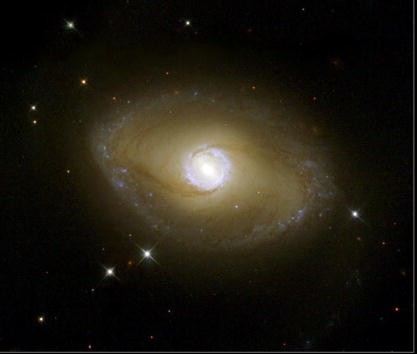What Are The First Stars In The Cosmos?
| KJ Belonio | | Jun 18, 2015 05:00 AM EDT |
(Photo : Getty Images/NASA) Astronomers have recently discovered the brightest galaxy in the early universe known as CR7. The newfound galaxy is also three times brighter than the brightest distant galaxy known up to now, the Himiko, which had been thought to be one of a kind.
Do you ever wonder what the first stars in the cosmos are? Well, thanks to the astronomers, we won't have to wonder anymore. They recently discovered compelling proof about the first generation of stars.
For years, astronomers have hypothesized the existence of Population III stars, the first generation of stars that were born out of the chaotic primordial matter of the Big Bang. And as Big Bang forged gases such as hydrogen, helium and lithium, these pristine gases spun into stellar bodies that created light in the darkness of the universe, CNET has learned.
Like Us on Facebook
As the Population III stars became the turning point of the universe, they take in the gases, which turn them into heavier elements like carbon, oxygen, iron, nitrogen and other metallic elements.
In a recent study helmed by a team of astronomers from the Institute of Astrophysics and Space Sciences, the Faculty of Sciences of the University of Lisbon in Portugal, and Leiden Observatory, in the Netherlands, astronomers discovered a galaxy known as CR7.
Using the Very Large Telescope (VLT) of the European Southern Observatory and with the assistance from the W.M. Keck Observatory, the Subaru Telescope and NASA's Hubble Space Telescope, they spotted signs indicating the presence of the oldest stars in the universe.
The newfound galaxy is considered the brightest galaxy in the early universe. It is also three times brighter than the brightest distant galaxy known up to now, the Himiko, which had been thought to be one of a kind. According to Astronomy magazine, these enormous, dazzling and formerly theoretical objects were the makers of the first elements in history.
David Sobral, the leader of the team, said that they were able to obtain insights on the ancient universe from a period known as reionization, approximately 800 million years after the Big Bang. And rather than conducting a narrow and profound study of a small area of the sky, they widened their scope to share the broadest survey of distant galaxies ever endeavored.
The team also discovered and confirmed a number of surprisingly bright young galaxies. And with the discovery of CR7 and other bright galaxies, the study was already deemed a success. However, further inspection is needed to provide additional and more exciting news.
"The discovery challenged our expectations from the start, as we didn't expect to find such a bright galaxy," Sobral stated.
Sobral added that by unveiling the nature of the CR7 piece by piece, the team was able to understand that they had not only found the most luminous distant galaxy, they had also realized that it had every single characteristic expected of Population III stars, which were the ones that formed the first heavy atoms that ultimately allowed life to exist.
As detailed in The Astrophysical Journal, the research indicated that the formation of Population III stars had occurred in waves as had been predicted. NBC News reported that the team also directly observed that the last wave of Population III stars suggested that they reside among regular stars in brighter galaxies.
The team also found that CR7 had areas that didn't emit signals for any heavier elements, hinting they were probably clusters of Population III stars. However, these Population III stars would have been ephemeral, as they exploded as supernovas after 2 million years of blazing life.
And through the latest discovery of the first stars in the cosmos, a clearer insight explained the significance of these elements in forging the stars around us today, the planets that orbit them, and life as we know it.
TagsStar, outer space, solar system, Cosmos, Science, telescope, Astronomy, NASA
©2015 Chinatopix All rights reserved. Do not reproduce without permission
EDITOR'S PICKS
-

Did the Trump administration just announce plans for a trade war with ‘hostile’ China and Russia?
-

US Senate passes Taiwan travel bill slammed by China
-

As Yan Sihong’s family grieves, here are other Chinese students who went missing abroad. Some have never been found
-

Beijing blasts Western critics who ‘smear China’ with the term sharp power
-

China Envoy Seeks to Defuse Tensions With U.S. as a Trade War Brews
-

Singapore's Deputy PM Provides Bitcoin Vote of Confidence Amid China's Blanket Bans
-

China warns investors over risks in overseas virtual currency trading
-

Chinese government most trustworthy: survey
-

Kashima Antlers On Course For Back-To-Back Titles
MOST POPULAR
LATEST NEWS
Zhou Yongkang: China's Former Security Chief Sentenced to Life in Prison

China's former Chief of the Ministry of Public Security, Zhou Yongkang, has been given a life sentence after he was found guilty of abusing his office, bribery and deliberately ... Full Article
TRENDING STORY

China Pork Prices Expected to Stabilize As The Supplies Recover

Elephone P9000 Smartphone is now on Sale on Amazon India

There's a Big Chance Cliffhangers Won't Still Be Resolved When Grey's Anatomy Season 13 Returns

Supreme Court Ruled on Samsung vs Apple Dispute for Patent Infringement

Microsoft Surface Pro 5 Rumors and Release Date: What is the Latest?










